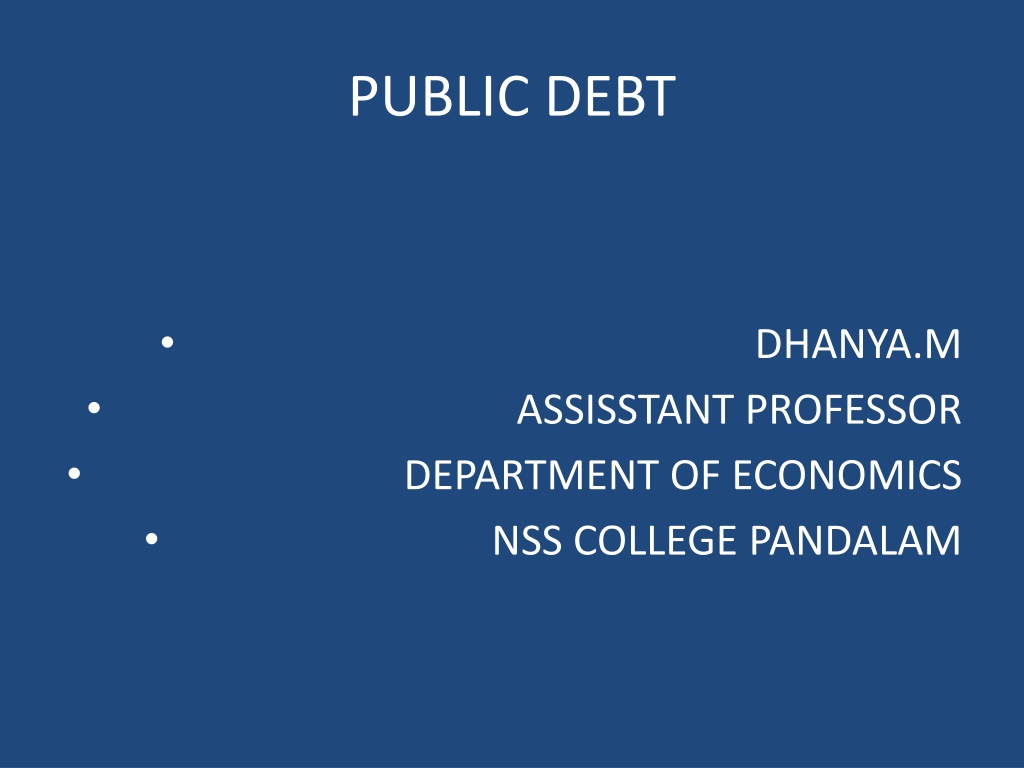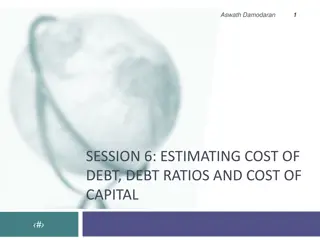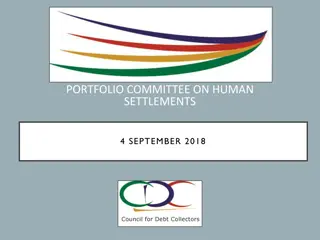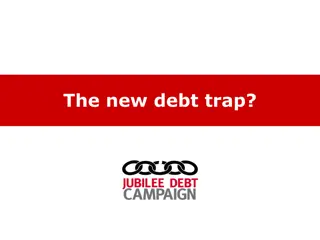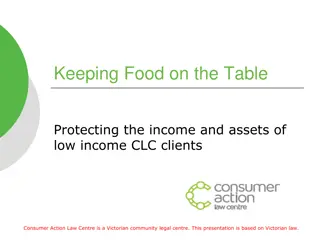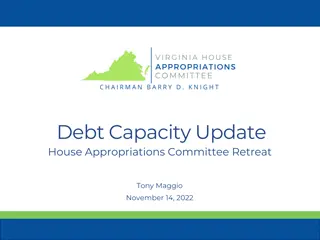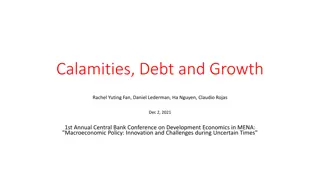Public Debt: Objectives and Classification
Public debt plays a crucial role in government finances, serving various objectives such as deficit financing, economic development, and infrastructure creation. It can be voluntary or compulsory, funded or unfunded, internal or external, and productive or unproductive. Furthermore, public debt can be classified based on its term, redeemability, and purpose, offering insights into how governments manage their finances.
Download Presentation

Please find below an Image/Link to download the presentation.
The content on the website is provided AS IS for your information and personal use only. It may not be sold, licensed, or shared on other websites without obtaining consent from the author. Download presentation by click this link. If you encounter any issues during the download, it is possible that the publisher has removed the file from their server.
E N D
Presentation Transcript
PUBLIC DEBT DHANYA.M ASSISSTANT PROFESSOR DEPARTMENT OF ECONOMICS NSS COLLEGE PANDALAM
PUBLIC DEBT Among the non-tax sources, the major source of revenue of the government is public debt. That is, borrowing. It may either be internal or external debts. When the government raises revenue by borrowing from within the country, it is called internal debt. Similarly, if the government is borrowing from the rest of the world, it is a case of external debt.
Objectives of public debt 1)To bridge the budget deficit (Deficit Financing) 2) To fight against depression. 3) To check inflation. 4) To finance economic development. 5) To meet unforeseen emergencies 6) An alternate source of income when taxable capacity is reached. 7) To finance wars.
8) To finance public enterprises 9) To carry out welfare programmes. 10) To create infrastructure. 11) For creation of productive assets. 12) For creation of essential non-income yielding assets (provision of public goods)
Classification of Public Debt VOLUNTARY AND COMPULSORY DEBT 1.Voluntary debt is the debt which is not paid by any legal enforcement. Whereas compulsory debt is legally forced in nature. Here people have no option but repay the debt. FUNDED AND UNFUNDED DEBT 2.Funded debt is long term or definite period debt. A proper agreement and terms and conditions of repayment with the percentage of interest payable are declared. They are used for creation of permanent assets.
Unfunded debt is for a short term and for indefinite period. It is paid through the income received from other sources. These are used for meeting current needs. INTERNAL AND EXTERNAL DEBT When the government raises revenue by borrowing from within the country, it is call internal debt. Whereas if the government is borrowing from the rest of the world, it is case of external debt. PRODUCTIVE AND UNPRODUCTIVE DEBT Loans on Projects yielding income (Construction of plants, railways, power schemes etc.) are called productive debt. Loans on non income yielding projects are called unproductive loans (war, famine relief etc.)
REDEEMABLE AND IRREDEEMABLE DEBT Redeemable debts refers to the loan which the government promises to pay off at some future date. Irredeemable debts are those, principal amount of which are never returned by the government but pays interest regularly. SHORT / MEDIUM/ LONG TERM LOANS: Short term loans are usually incurred for a period varying from three months to one year. Usually governments get such loans from the central bank by using treasury bills. These loans are calls ways and means advances.
Medium Term loans are those which are obtain for more than one year but less than ten years. Long term loans are those which are obtain for more than ten years. These are used to finance developmental activities
REDEMPTION OF PUBLIC DEBT Redemption of public debt means repayment of a loan and it is an important responsibility of the government. All government loans should be repaid.
METHODS OF REPAYMENT OF DEBT Repudiation: It means refusal to pay a debt by governments. This method was followed by the USA after the civil war and by the USSR after the 1917Revolution. This method is undesirable and has not been used recently anywhere in the world. Repudiation shakes the confidence of the people in public debt and many provoke retaliation from creditor countries.
Refunding: Refunding is the process of replacing maturing securities with new securities. In some cases the bonds may be redeemed before the maturing date when the government intends to rearrange the maturity of outstanding debts or when current rate of interest is low. The drawback of this method is that government is tempted to postpone its obligation of debt redemption. This leads to a continuous increase in the burden of public debt in future.
Conversion of Loans: It is a special type of refunding. Conversion of existing securities into new securities before maturity. It is generally resorted to reduce the burden of debt by converting high interest loans into low interest loans
Sinking Fund Sinking fund is a special fund created for the repayment of public debt. According to this method, the government sets aside a certain amount out of the budget every year for this fund. The balances in the funds are also invested and the interest accruing on them is also credited in the fund.
Capital levy Capital levy is a special type of once for all tax on capital imposed to repay war debts. All capital goods are taxed above a minimum level of assets possessed by residents of the country. Simply, capital levy refers to a very heavy tax on property and wealth. This tax was levied immediately after the First World War.
Surplus budget: Quite often, surplus budget may be used to clear public debt. But in recent times due to the ever increasing public expenditure, surplus budget is a rare phenomenon. Buying up of Loans: Governments redeems debt through buying up loans from the market.
Deficit financing Mc. Graw Hill Dictionary of Modern Economics defines deficit financing as a practice by government of spending more than what it receives as revenue. Thus a government is said to be practicing deficit financing when it spends in excess of its current revenue .
Deficit Financing In India In Indian context deficit financing takes place The government may withdraw its cash balances from the central bank or Government may borrow fund from the central bank or Government may resort to printing of additional currency
Deficit financing has been used in India to cover budgetary deficits. The GOI borrowing from RBI to cover budgetary deficit is deficit financing in India. The extent of deficit financing is increasing throughout the plans. The effects include large increase in money supply and it leads to inflation. It leads to reduction in investment and will lead to speculative activities.
OBJECTIVES OF DEFICIT FINANCING To meet financial needs of government To increase output and employment To mobilize surplus, idle and unutilized resources To divert resources from unproductive to productive uses To stimulate effective demand and investment.
The Revenue Deficit of the Government of India was Rs. 85233 crores during the year 2000-01. It increased to Rs. 394472 crores during the year 2015-16 (BE) showing an increase of Rs. 309239 crores during the period from 2000-01 to 2015-16. In percentage terms, the overall growth was 362.82% during the period. The annual rate of growth in percentage terms was 24.19% during the period from 2000-01 to 2015-16. The Fiscal Deficit of the Government of India was Rs. 118816 crores during the year 2000-01. It increased to Rs. 555649 crores during the year 2015-16 (BE) showing an increase of Rs. 436833 crores during the period from 2000-01 to 2015-16. In percentage terms, the overall growth was 367.66% during the period. The annual rate of growth in percentage terms was 24.51% during the period from 2000-01 to 2015-16.
BUDGET The term budget has been derived from a French word bougette which means a leather bag or purse. The term budget is commonly understood as a document presented by a government containing an estimate of proposed expenditure for a given period and proposed means of financing them for the approval of legislation.
A Budget includes a) financial actions of the previous year b) budget and revised estimates of the current year and c) the budget estimates for the following year. The budget is presented in the parliament by the Union Finance Minister Presented on the last working day of February.
Features of Budget 1) It is a statement of expected revenue and proposed expenditure. 2)It is sanctioned by some authority. 3) It s periodicity, is generally annual and 4) It prescribes the manner in which revenue is collected and expenditure is incurred. Budget is prepared on cash basis. 6) All unutilized funds within the year lapse at the end of the financial year.
Types of Budgets Balanced Budget: - A balanced budget is that over a period of time, revenue does not fall short of expenditure. i.e., revenue is equal to expenditure (Revenue=Expenditure). Unbalanced Budget: The Budget imbalance may be due to an excess of expenditure over income or an excess of income over expenditure. In other words, budget may either be surplus or deficit. A budget is said to be surplus when public revenue exceeds public outlay
Revenue and Capital Budget Revenue budget consists of revenue receipts of Govt .Revenue receipts comprises of tax revenues and other revenues of Govt. Capital budget consists of capital receipts and expenditure. Capital receipts consists of loans raised by Govt from public and capital expenditure consists of expenditure on buildings, machinery ,investment in shares etc.
Revenue deficit is the excess of revenue expenditure over revenue receipts. Revenue Deficit= Revenue Receipts-Revenue Expenditure Primary Deficit is the excess of fiscal deficit over interest payments. Primary Deficit = Fiscal deficit- Interest payments
Budgetary deficit=TotalRevenue-TotalExpenditure Fiscal Deficit is the excess of total budget expenditures over the total budget revenue excluding borrowings. Fiscal Deficit=budgetary deficits+ borrowing and other liabilities The significance of fiscal deficit is that it is a measure of total borrowing requirements of the government. It shows the extent of dependence of the government on borrowings to meet its budget expenditure
Consolidated Fund All sums of money, all revenues of the governments, the loans raised by it, receipts by way of repayment of Loans constitute the consolidated fund. All expenditures are also incurred out of this fund. No amount can be withdrawn from this fund without the sanction of the parliament. [Article 266 (1)]
The Contingency fund:- The fund is placed at disposal of the President to enable the government to meet the unforeseen emergencies. Prior sanction of the parliament is not required to spend from the fund.[Article 267]
Public Account:-Certain transactions are not included in the contingency fund. They include transactions relating to provident funds, small savings collections,other deposits etc. The money thus received is kept in public account. This money does not belong to the government. It has to be paid back to the persons and authorities who have deposited it.
Budgetary procedure in India 1. Preparation of the Budget 2. Presentation and enactment of the budget and 3. Execution of the Budget
1. Preparation of the Budget Budget for a year is prepared by the Budget Division in the Ministry of Finance broadly on the basis of detailed estimates of expenditure receivedfromvarious Departments/Ministries of Government of India and its own subordinate estimating authorities. Budget estimates are prepared in August or sept by district officers and send to HOD s.Theyhave to fill prescribed forms.
The prescribed form has four different columns: a) Actuals of the previous year. b) Sanctioned estimates for the current year. c) The revised estimates for the current year and d) The budget estimates for the next year
Presentation and enactment of the budget Presentation of Budget in Parliament: the budget is presented in the parliament by the government in the case of Central government and before the respective assemblies of the states in the case of state budgets. The budget is presented by the Finance Minister in the LokSabha and by a Junior Minister in the RajyaSabha. The Finance Minister makes a detailed budget speech at thetime of presenting the budget before the LokSabha
General Discussion: A general discussion takes place in both houses of the Parliament after the presentation of the budget. The members of the parliament have a right to criticize the various proposals and estimates as shown in the budget. Voting: The Lok Sabha starts examining the the estimates or the demands for grants ministry wise. After the discussion, the demands of each ministry are voted.
Passing of the Appropriation Bill: Moneybill or appropraition bill has to be passed for getting legal sanction to utilise consolidated fund. Passing of the Finance Bill: The finance bill is presented before the Parliament after passing the money bill. The finance bill when passed becomes the Act which authorizes the government to collect the required money through taxation or by other devices.
EXECUTION OF THE BUDGET After passing the budget, the question of its execution arises. The responsibility to execute the budget lies with the respective governments.. The execution of the budget has three aspects: 1) Distribution of grants to different administrative ministries or departments 2) Collection of revenue(Central Board of Direct and Indirect Tax Collects) 3) Proper custody of collected funds(dist.treasury is unit of fiscal system)
Zero-based budgeting (ZBB) Zero-based budgeting (ZBB) is a method of budgeting in which all expenses must be justified for each new period. The process of zero-based budgeting starts from a "zero base. Pete Pyhrr developed zero-based budgeting. Every year is taken as a new year and budget for this year is justified according to present situation.
STEPS IN ZBB . IDENTIFYING THE DECISION UNITS First and foremost step involved in the zero-based budgeting process is, identifying the decision unit. A decision unit can be a single activity or a cluster of activities which can be independently and meaningfully identified. By independent, we mean an activity which is isolated and not overlapping other activities. So every decision unit will be separate from each other. An organization is divided into many decision units.
MAKING DECISION PACKAGES In this step, the decision units that were identified in the first step are broken down into smaller decision packages. These decision packages must be in line with the objectives of the organization.
A formal decision package must contain the following information: The task for which the decision package is made Goals and objectives of the decision package Analyzing the need for the task Analysis of the technical and operational viability of the task Analyzing the alternative course of action
RANKING DECISION PACKAGES This is the third step involved in the zero-based budgeting process. In this step, all the decision packages within a decision unit and among various decision units are ranked in the order of their importance and priority. The logic behind prioritizing decision packages is to have an efficient allocation of scarce resources. Decision packages are ranked based on the cost-benefit analysis. While doing this, all the alternatives options are evaluated so as to select all the better and cost-effective options
ALLOCATING AVAILABLE RESOURCES This zero-based budgeting step an extension of the previous step. The decision packages that are ranked in the previous step are allocated funds in this step. So we can say that in this step funding decisions are made. The allocation of funds and other resources are based on the ranking of decision packages.
CONTROLLING AND MONITORING This is the last step in preparing zero-based budgeting. In this step, decision packages are monitored and evaluated for their performance and output. Measuring the performance of the decision packages helps the management to understand whether the allocation of resources is done accurately or not.
PLANNINGPROGRAMMING BUDGET SYSTEM(PPBS) PPBS introduced in United States during 1961-62.PPBS helps to integrate long range planning of Govt. activities and arrange to schedule specific activities in future. It makes use of quantitative techniques(system analysis and cost benefits) in the evaluation of different proposals.
STAGES OF PPBS Specification of Objectives- Objectives have to be specified with long term goals in quantitative terms. Systemic Analysis-The Pgm objectives are anlysed with the cost benefit and cost effectiveness analysis. Functional Classification-Classified on functional basis such as programmes,projects and activities.
Organisation-The organisational structure ,managerial and administrative procedures of programmes is addressed. Evaluation-Evaluation of performance and corrective steps for defects ,if any.
ADVANTAGES 1.Assessment of performance is done in the method. 2.It is a reliable guide for both executive and legislature 3.It attempts to promote maximum social advantage. 4.It helps for future programming. 5.It has a knowledge of economic problems and helps to solve problems.
